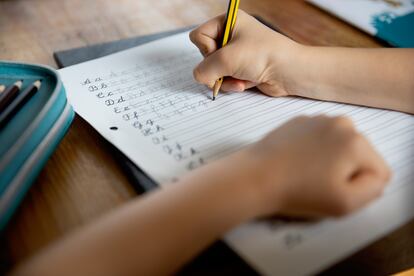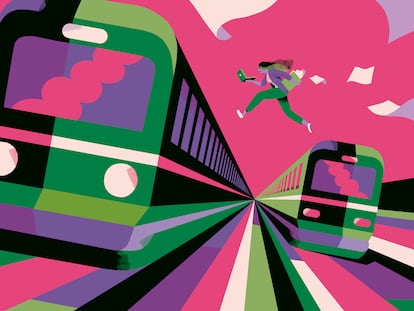Is our handwriting getting worse? It’s not just technology that affects our way of writing
In the age of digitalization we are using pen and paper less and less, but in addition to the lack of handwritten letters, there are other external factors that cause calligraphy to undergo certain modifications

In Valencia, in the mid-20th century, a young bank employee and professor of business administration named Ramón Rubio founded a small academy aimed primarily at training candidates who aspired to become accountants in their professional development. To provide extra support for his classes, Rubio created a system of cards with which his students could reinforce the knowledge they had acquired in accounting and calligraphy at home. Over time, these cards were bound together and became the seed of what is now known as the Rubio Notebooks, famous for improving — since the 1970s — the calligraphy of many generations who, thanks to Rubio’s foresight, developed the necessary skills to acquire ease and agility when writing. The type of letter that was produced with these notebooks was the classic connected letter, in which each letter is joined to the next with a series of strokes making it unnecessary to lift the pencil from the paper until there is a space between words. Visually, it is very different from the print or script typeface that predominates today. The latter does not have ligatures between the letters and is a faster way of writing.
While students used to write their classwork and notes by hand during high school and university, now they do so with a tablet or computer. This lack of handwriting practice is clearly reflected in calligraphy, which has evolved by losing the ligatures between letters and has adopted forms more similar to those of printed letters. To understand this change, it is necessary to examine the factors that determine an individual’s way of writing. “Handwriting is like a biography of oneself. In reality, one begins to write at school as one is taught and the legibility of the handwriting will depend, in part, on the quantity and quality of the calligraphy practiced during childhood,” explains Elena Giner Muñoz, a graphologist and expert in calligraphy. “Then, during adolescence, one begins to deviate a little from the calligraphic pattern; one begins to personalize it, to make it more one’s own. Over time, as a person’s personality develops, a series of graphological features are established that will remain intact in adulthood and that, in the eyes of a graphology specialist, will say a lot about the person who is writing,” adds the Open University of Catalonia associate professor and author of the book Graphology.
As such, if calligraphy is a reflection of our personality and changes over time based on our experiences, it would be easy to deduce that digitalization is destroying our handwriting. “What we are experiencing is a process of depersonalization of the handwriting in those generations that have already grown up subject to writing on computers, tablets, or mobile phones,” says Giner. And while this makes graphological study increasingly difficult, it does not mean that handwriting is in danger of extinction.
Handwriting has very obvious advantages over typing. Several studies confirm that handwriting requires greater brain activity. The linguist José Antonio Millán, in his essay The strokes that speak. The triumph and abandonment of handwriting (2023), clarifies: “The manuscript requires fine psychomotor skills of the dominant hand: what the student’s brain stores is not the shape of a letter, but the entire program of arm, wrist, hand, and finger movements that produce it. Whoever writes by hand must set out in advance the spatial requirements such as linearity, spacing, and speed.” However, Millán continues: “The keyboard mobilizes both hands with coarser motor skills, and requires brain involvement that has more in common with activities such as playing the drums.” This influences the cognitive level, since it has been shown that handwriting favors the mental retention of information by requiring greater brain involvement in its execution.
According to a recent report by the Organisation for Economic Co-operation and Development (OECD), students who often read on paper memorize concepts better than those who do so from electronic devices. Therefore, it is clear that there is a direct relationship between the sensorial involvement of human beings — contact with paper and pen — and how the brain processes and stores information. But, leaving aside the formative stage, it is worth asking whether once we have passed adolescence, and in full development of adulthood, the lack of use of handwriting in favor of typing is causing a deterioration in the quality of our handwriting.
Has lack of habit impoverished handwriting?
Forensic graphologist Ana Ortiz de Obregón, an expert in diagnostic, pathological, therapeutic and judicial graphology, explains to EL PAÍS: “Handwriting has not worsened because of technology, but rather it has evolved in accordance with our life experiences and the passage of time. Although we now write less by hand, a person who knows how to write always knows how to write. It is like riding a bicycle. At first you are more careful to make the handwriting more esthetic, but as you write, the conscious gives way to the unconscious; the act of writing becomes mechanized and that is when the brain begins to draw a self-portrait on paper, detectable from a graphological point of view.” In this sense, it is not so much the lack of use of handwritten letters but other external factors that cause handwriting to undergo certain modifications. For example, writing when rushed, the possibility of a neuronal disease, the emotional state of the individual at the time of writing, etc.
In recent years, the effort to recover the forms of a more visually neat handwriting has led to the proliferation of courses and activities such as lettering, which aims to draw the letters giving them a more esthetic than practical sense. But, is it possible to try to change an adult’s handwriting while prioritizing its beauty? Ortíz de Obregón makes an interesting reflection on this: “With the passage of time it is fundamental that the letter becomes uglier. This means that you have broken the calligraphic pattern you were taught at school, where we all learned to write the same way. Therefore, your handwriting is unique and, over time, it becomes a reflection of your personality. Trying to modify it or imposing a handwriting that is not really your natural style could be a symptom that you want to hide something, although it does not necessarily have to be something bad. It could be insecurity, lack of confidence, or excessive control over your self-image.”
Sign up for our weekly newsletter to get more English-language news coverage from EL PAÍS USA Edition
Tu suscripción se está usando en otro dispositivo
¿Quieres añadir otro usuario a tu suscripción?
Si continúas leyendo en este dispositivo, no se podrá leer en el otro.
FlechaTu suscripción se está usando en otro dispositivo y solo puedes acceder a EL PAÍS desde un dispositivo a la vez.
Si quieres compartir tu cuenta, cambia tu suscripción a la modalidad Premium, así podrás añadir otro usuario. Cada uno accederá con su propia cuenta de email, lo que os permitirá personalizar vuestra experiencia en EL PAÍS.
¿Tienes una suscripción de empresa? Accede aquí para contratar más cuentas.
En el caso de no saber quién está usando tu cuenta, te recomendamos cambiar tu contraseña aquí.
Si decides continuar compartiendo tu cuenta, este mensaje se mostrará en tu dispositivo y en el de la otra persona que está usando tu cuenta de forma indefinida, afectando a tu experiencia de lectura. Puedes consultar aquí los términos y condiciones de la suscripción digital.
More information
Archived In
Últimas noticias
The life of a delivery driver in China: ‘Many people don’t know how an order can arrive at their home in just one day’
Maude Apatow, from acting in ‘Euphoria’ to directing: ‘There are many films that you can tell weren’t written by someone young’
The guardians of the meteorites of the Argentine Chaco
Helen Levitt, the photographer who captured the theater of the everyday
Most viewed
- Christian Louboutin: ‘Young people don’t want to be like their parents. And if their parents wear sneakers, they’re going to look for something else’
- US sanctions against jailed cartel leader ‘El Marro’ highlight Mexico’s lack of control over its prisons
- Cartels in Mexico take a leap forward with narco-drones: ‘It is criminal groups that are leading the innovation race’
- Liset Menéndez de la Prida, neuroscientist: ‘It’s not normal to constantly seek pleasure; it’s important to be bored, to be calm’
- ‘El Limones’ and the growing union disguise of Mexican organized crime










































